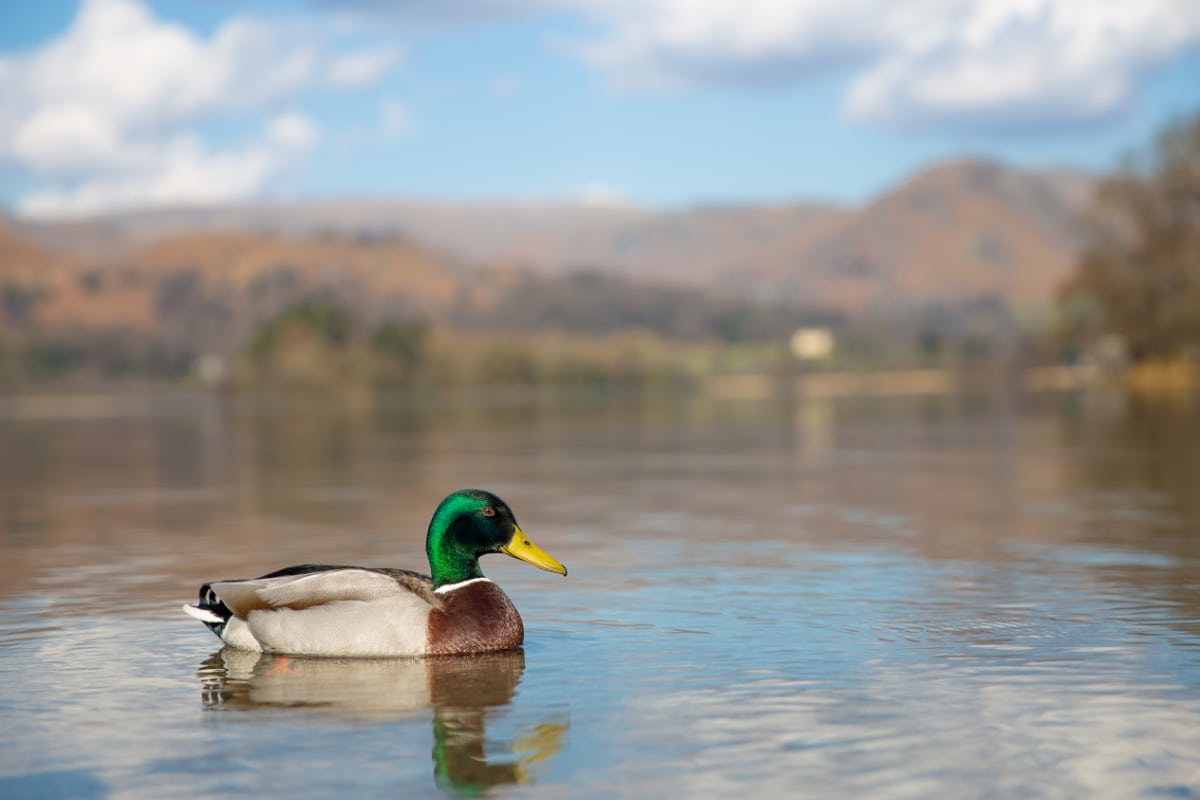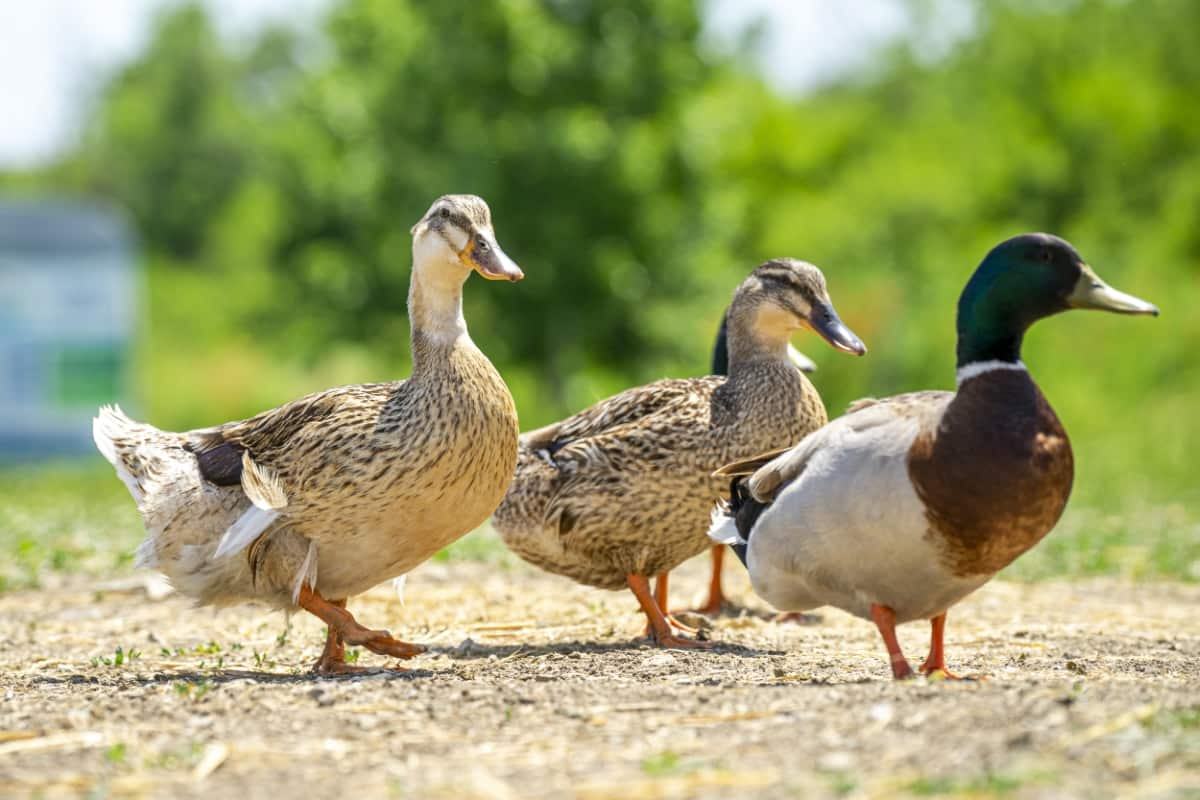The Silver Appleyard Duck, developed by British waterfowl breeder Reginald Appleyard in the 1930s, is renowned for its dual-purpose capabilities. Bred from Khaki Campbells, Rouen, and Runner ducks, it combines excellent meat quality with prolific egg production. Known for its striking silver and white plumage, the breed gained recognition for its utility and beauty.

Originally bred for the British market, it later found popularity worldwide. The Silver Appleyard’s resilient nature and versatility make it a favored choice for backyard poultry enthusiasts, contributing to its continued success in various climates and regions.
All You Need to Know About Silver Appleyard Duck
Physical Characteristics
- Size: Silver Appleyard ducks are medium to large-sized waterfowl, with males weighing around 3.6-4.5 kg and females slightly lighter at 3.2-4.1 kg.
- Coloration: They exhibit a striking appearance with a silver-white or creamy-white plumage adorned with distinct black or gray penciling, creating a beautiful contrast.
- Bill: The ducks feature an orange bill that complements their overall coloration, and it is relatively broad and moderately long.
- Head and Neck: Their head and neck display a rich chestnut brown color, providing a distinctive and appealing look.
- Eyes: The eyes of Silver Appleyard ducks are typically dark brown, contributing to their expressive and lively facial features.
- Body Shape: These ducks have a well-rounded body with a slightly elongated appearance, giving them an elegant yet robust physique.
- Legs and Feet: The legs and webbed feet are orange, providing mobility and adaptability for their semi-aquatic lifestyle.
Behaviour/Temperament
The Silver Appleyard Duck is known for its friendly and calm demeanor, making it an excellent choice for backyard flocks. Displaying a sociable nature, these ducks are easily approachable and enjoy human interaction. They are docile, making them suitable for families and beginner duck keepers.
Their gentle temperament extends to other ducks and animals, promoting a harmonious environment. Silver Appleyards are also known for their inquisitive and curious behavior, exploring their surroundings with enthusiasm. While they may exhibit some natural foraging instincts, they are generally well-behaved and adaptable, thriving in various living conditions.
Breeding
Begin with selecting healthy breeding stock, ensuring they exhibit the breed’s distinctive silver-blue and white coloration. Female ducks, or hens, typically start laying eggs around five to six months of age. Provide a comfortable and secure nesting environment to encourage egg-laying. During the breeding, which typically occurs in spring and summer, maintain a balanced diet rich in nutrients to support optimal reproductive health.
In case you missed it: Khaki Campbell Ducks: Profile, Characteristics, Price, Size, Lifespan, and Egg Production

Adequate access to clean water is crucial for both the ducks’ well-being and the development of healthy eggs. To promote successful incubation, consider using an incubator or allowing a broody hen to hatch the eggs naturally. The incubation period for Silver Appleyard eggs is around 28 days. Once the ducklings hatch, provide a warm and safe environment, with access to water for swimming and high-quality duckling feed.
Care and Management
- Provide a spacious and secure duck house with good ventilation. Ensure protection from predators, and use bedding like straw for comfort.
- Offer a balanced diet of commercial duck pellets, grains, and fresh greens. Provide access to clean water for drinking and bathing; ducks need ample water.
- Schedule regular check-ups with a veterinarian. Vaccinate against common diseases and maintain a clean living environment.
- Silver Appleyards are known for good egg production; provide nesting boxes for laying. Collect eggs daily to prevent broodiness and ensure optimal laying conditions.
- Ducks are relatively low-maintenance, but keep an eye on feathers and trim as needed. Provide a shallow pool or pan for bathing to help with grooming.
- Ducks are hardy, but ensure they are comfortable in varying temperatures. Provide shade during hot weather and a well-insulated duck house in colder climates.
- If breeding, monitor mating behavior and ensure a safe, secluded area for nesting. Provide extra care to ducklings, including a starter diet and a warm, secure brooding area.
Uses
- Ornamental Bird: Silver Appleyard Ducks are prized for their attractive appearance, featuring silver-white plumage with distinctive blue-colored bills and orange legs.
- Excellent Egg Layers: Hens are prolific layers of large white eggs, making them valuable for backyard poultry enthusiasts and small-scale farmers.
- Quality Meat Production: Renowned for their flavorful meat, Silver Appleyards are raised for their high meat-to-bone ratio, making them suitable for both meat production and consumption.
- Friendly Disposition: Known for their calm and friendly nature, they are often kept as pets or in educational settings for their docile temperament.
- Exhibition and Shows: Frequently showcased in poultry exhibitions and competitions due to their unique and eye-catching features.
Egg Laying
This breed excels in egg production, with females laying approximately 220 to 290 large white eggs annually. Their consistent and reliable egg-laying capabilities make them a popular choice for backyard poultry enthusiasts. The Silver Appleyard’s combination of ornamental features and productive egg-laying qualities contributes to its appeal as a dual-purpose breed, serving both aesthetic and practical purposes in domestic flocks.
Lifespan
The Silver Appleyard Duck, a dual-purpose breed known for its striking appearance and excellent egg and meat production, typically has a lifespan of 4 to 8 years. With proper care, including a balanced diet, adequate shelter, and protection from predators, Silver Appleyards can lead healthy lives, providing companionship and productivity to their owners for nearly a decade.
In case you missed it: Everything You Want to Know About Flying Duck Orchid: Explore from Life Cycle to Cultivation

Price
The Silver Appleyard duck, known for its striking appearance and excellent egg-laying abilities, typically ranges in price from $15 to $20 per duck. Prices may vary based on age, gender, and breeder reputation. Reputable breeders may charge higher prices for ducks with desirable traits or show quality. Buyers should research and choose a reputable source to ensure they are getting a healthy and well-bred Silver Appleyard duck.
Overview of Silver Appleyard Duck
| Duck Name | Silver Appleyard Duck |
| Duck Purpose | Meat, Egg-laying, and ornamental plumage. |
| Feather color | White and yellow with green or brown coloration |
| Weight | 3.1 to 4.5 Kg. |
| Climate Tolerance | All climates |
| Egg Color | White |
| Egg Size | Big |
| Egg Productivity | High (220 to 270 eggs in the year) |
| Rarity | Normal |
| Country of Origin | United Kingdom |
| Price | $15-20 |
In case you missed it: Saxony Duck Breed: Physical Appearance, Temperament, Egg Production

Conclusion
In conclusion, the Silver Appleyard Duck is a delightful and versatile breed known for its attractive appearance, friendly temperament, and dual-purpose qualities. Whether you’re interested in raising them for meat and eggs or as charming additions to your backyard flock, Silver Appleyard ducks make an excellent choice with proper care and attention. Considered a heritage breed, they contribute not only to agricultural sustainability but also to the enjoyment of small-scale poultry enthusiasts.
Note: The images presented in this post are intended solely for representation purposes. The images are meant to serve as visual aids and should not be relied upon as accurate representations of their real-life counterparts.
- Feed Your Flock for Less: Top 10 Tips to Save on Chicken Feed
- Ultimate Guide to Ossabaw Island Hog: Breeding, Raising, Diet, and Care
- Hatching Answers: The Top 10 Reasons Your Chickens Aren’t Laying Eggs
- Eggs and Economics: Breaking Down the Cost of Raising Backyard Chickens
- Defend Your Greens: Proven Methods to Keep Iguanas Out of Your Garden
- Ultimate Guide to Cinnamon Queen Chicken: A Comprehensive Guide for Beginners
- Ultimate Guide to California Tan Chicken: Breeding, Raising, Diet, Egg-Production and Care
- Ultimate Guide to Marsh Daisy Chicken: Breeding, Raising, Diet, and Care
- 10 Types of Chicken Farming Businesses You Can Start for Profits